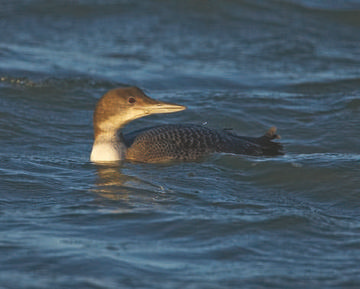Great Northern Diver (Gavia immer)

Great Northern Diver © Richard Steel
This species is scarce on Irish Sea coasts, most birds being found in Ireland and the north and west of Scotland (BTO Winter Atlas). All of the UK sites with WeBS counts in double figures are in Scotland. This northwesterly distribution reflects the origins of the wintering population. Their breeding grounds are unknown, but those in our waters must include birds from Iceland, Greenland and northern Canada. Great Northern Divers spend the winter in deeper water, farther offshore than the other divers, and are also less susceptible to being blown towards land, so this species is difficult to record at the coast. Paradoxically, though, this is the most likely diver to be found inland.
Coward (1910) wrote of the Great Northern Diver as ‘an occasional winter visitor to the coast and inland waters, and birds passing northward have been met with in spring’. Bell (1962) thought that that statement of status ‘would hold good up to the present time’, noting that ‘it is nowadays seen in most years off Hilbre, particularly since about 1950 when that area has been very fully watched’. That assertion was quantified during the period 1957-1977 with a total of 50 bird-days from mid-November to February (Craggs 1982). Daily records rarely exceeded two but a remarkable eight were noted on 24 December 1961. Boyd (1946) seems to have overstated the position when he wrote that the Red-throated Diver is a bird rarely seen on the Cheshire meres, although the larger bird occurs almost every winter, and he was probably influenced by a run of such records during the 1930s. There was another coincidence of inland birds in late 1963 when Great Northern Divers made stays of various lengths at Tatton, Combermere and Budworth Mere, with sightings at all three on 1 December (Bell 1967).
In the thirty winters since 1977/ 78 the county bird reports list sightings in 23, with both coastal and non-coastal records in eight winters, ten winters with coastal records only and five winters with only inland records. The sightings are sparse, however, from one to four per winter, with most records of solitary birds and the only multiple sightings from Hilbre, two birds in three winters and three birds on 12 January 1986. Most birds are seen from Hilbre, but there are coastal records from New Brighton to the mouth of the Dee off Caldy. Birds are more random in their choice of inland waters but they have appeared in three winters at both Budworth Mere (SJ67N/ T) and Farmwood Pool (SJ87B). A feature of this species’ inland visits is that they usually tend to stay at a site for a week or more, with the record held by one that remained at Farmwood Pool from 13 November 1982 to 5 February 1983. As with all divers, they feed mostly on small fish and crustaceans and their diet is not tied to marine organisms.
Thus, the records during this Atlas were fairly typical, in distribution and numbers. No birds at all were reported in winter 2004/ 05, with just one in 2005/ 06, at Hilbre. Four records came in 2006/ 07, at Hilbre, one on West Kirby Marine Lake for about two weeks, one seen on the river Mersey at Hale (SJ48W) and one that visited Astbury Lake, Congleton (SJ86L) for a morning.
Sponsored by Steve Kemp

